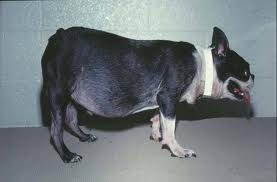Cushings Canine Syndrome: Something to Be Careful About


When my beautiful Siberian Husky was diagnosed with Cushing’s Syndrome, I never thought it would be the cause of my losing her, in spite of all the attention and care I provided. I had taken her to the clinic I normally went to because of a very unexpected convulsion and the veterinarian who saw her that day told me she had a tumor in the adrenal glands and should be kept under observation, but nothing else. That was the beginning of the end.
Some dog owners are careful enough to pay attention to different behaviors shown by their dogs and take action immediately, but others just think “it will probably pass”, “maybe it is nothing to worry about” or “we’ll see what happens in a few days”. I am not of the second type and kept observing some very unusual conducts I did not like, so I decided to have a second opinion immediately. Thank God for that, because the disease was properly diagnosed and explained to me in detail and the suggestion to operate was immediate. When the surgeon saw her, she confirmed the operation should take place right away because of what I told her my dog had done as part of the typical symptoms of the disease. Even though we did everything fast, Luna did not survive.
I will try to give some idea of what this syndrome is all about and which of the behaviors it produces have to be very carefully observed and controlled, hopefully for dog owners not to go through what I did and suffer what I suffered.
Cushing’s is a disease of the endocrine system in dogs. That system includes the glands that produce hormones, just like in human beings. In this particular case, the adrenal glands, which physiologically are placed near the kidneys, secrete cortisol in excessive levels. Cortisol is a steroid hormone.
Cushing’s is usually caused by a long time exposure of the dog to high levels of what are called glucocorticosteroids. These can be produced by the animal’s body itself or if the dog has been medicated for a long time with prednisone or other corticosteroids.
To give you an oversimplified idea of the whole process, the route of the problem is: tumors appear in the pituitary gland which is the one secreting the ACTH. These tumors stimulate the adrenal glands to produce large amounts of their hormones and it is this excessive production the responsible one for up to 85% of the observed cases of Cushing’s occurring spontaneously.
There are the other tumors of the adrenal glands themselves which produce corticosteroids and thus contribute to the other 15% of cases of the disease.
The most important thing for a dog owner to do, as I said before, is really observe changes in the dog’s typical behavior and be on the lookout for any of the following symptoms:
• Hair loss
• If skin can be observed, you will notice some bruising of dark spots which are caused by the blood vessels becoming fragile
• The abdomen may become pot-bellied
• Lethargy
• Infertility in females
• Excessive drinking and urination (these were some of the symptoms I observed in Luna)
• Weakness of the muscles
• Panting
• Convulsions
• Excessive appetite (the dog will not only eat its food, but anything else it has never eaten, such as paper, carton, rags, etc. My Luna ate a kitchen towel when I was not present that located itself between her stomach and the intestine and was the cause of her having such difficulties during the operation that she did not survive it even for one day)
• Insomnia
• Obesity
• Lack of menstrual period in females
• Shrinking of the testicles in males
If the tumor is operable, this is usually what is recommended, although there are certain drug treatments also available. In the latter case, it should be noted that these drugs can have side effects that can be of serious nature; therefore, dogs under these have to be closely monitored. Radiation has also been known to be administered with success in some cases.
Cushing’s is more commonly observed in middle-aged to older dogs and more frequently in females than males, and the following breeds seem to be more susceptible to it:
• Terriers
• Labrador Retrievers
• Boxers
• Dachshunds
• Poodles
• German Shepherds
Good dog owners are supposed to be affected if their dogs are victims of Canine Cushing’s Syndrome mainly because there is no cure for the disease, but if the dogs are promptly and effectively treated, they can still have good quality of life and so can their owners.
Always be observant of your dog’s changes in general and do not suppose you know the causes unless you are a veterinarian yourself. Also, if you are not satisfied with one veterinarian’s diagnosis or suggestions as I was, make sure you look for a second opinion as you would try with yourself or a member of your human family, of which your dog is also part.
